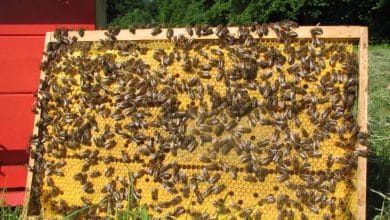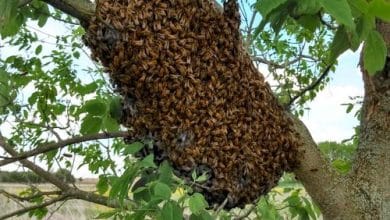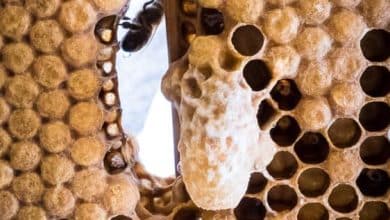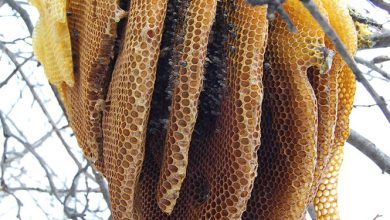Your Guide to Buying a Queen Bee

Buying a Queen Bee. The queen bee is the heart of the colony, responsible for laying eggs and maintaining a strong population. A high-quality queen bee can greatly benefit your hive in several ways.
Firstly, a good queen bee will ensure a steady supply of worker bees. Worker bees are essential for tasks such as collecting nectar, pollinating flowers, and producing honey. With a productive queen, your hive will have a larger workforce, resulting in increased honey production and overall colony strength.
Secondly, selecting a healthy and genetically diverse queen bee can help improve the resilience of your colony against diseases and pests. A strong genetic stock can provide better resistance to common threats such as Varroa mites or bacterial infections.
When buying a queen bee, there are several factors to consider. Look for reputable suppliers who breed queens from known genetic lines with desirable traits such as gentleness or hygienic behavior. It’s also important to choose queens that have been raised using sustainable methods without excessive use of pesticides or chemicals.
In conclusion, investing in a high-quality queen bee is essential for maintaining a thriving hive. By choosing carefully and considering important factors like genetics and supplier reputation, you can ensure the success of your apiary. Remember that a healthy and productive queen bee is key to the long-term success of your honeybee colony.
Benefits of selecting a high-quality Queen Bee for your hive
Selecting a high-quality queen bee for your hive can have numerous benefits. The queen bee is the heart of the colony, responsible for laying eggs and maintaining a strong population. By choosing a queen with desirable traits, you can greatly improve the health and productivity of your hive.
One significant benefit of selecting a high-quality queen bee is ensuring a steady supply of worker bees. Worker bees are essential for tasks such as collecting nectar, pollinating flowers, and producing honey. With a productive queen, your hive will have a larger workforce, resulting in increased honey production and overall colony strength.
Another advantage of choosing a healthy and genetically diverse queen bee is improved resilience against diseases and pests. A strong genetic stock can provide better resistance to common threats such as Varroa mites or bacterial infections. This can help safeguard your hive’s long-term survival.
When buying a queen bee, it’s crucial to consider factors such as genetics and supplier reputation. Look for reputable suppliers who breed queens from known genetic lines with desirable traits like gentleness or hygienic behavior. It’s also important to choose queens that have been raised using sustainable methods without excessive use of pesticides or chemicals.
In conclusion, investing in a high-quality queen bee is essential for maintaining a thriving hive. A healthy and productive queen ensures an adequate supply of worker bees while improving the colony’s resilience against diseases and pests. By carefully considering important factors when purchasing a queen bee, you set your apiary up for success in the long run.
Factors to consider when buying a Queen Bee
When buying a Queen Bee for your hive, there are several important factors to consider. These factors will help ensure that you select a high-quality and healthy queen that will thrive in your colony.
- Genetics: The genetic background of the queen bee is crucial. Look for queens that come from reputable breeders who prioritize traits such as productivity, gentleness, disease resistance, and hygienic behavior. Genetic diversity is also important for the long-term health and adaptability of your hive.
- Supplier reputation: Research the reputation of the supplier before making a purchase. Look for reviews or recommendations from other beekeepers to ensure that you are buying from a trustworthy source. This will help guarantee that you receive a healthy and well-cared-for queen bee.
- Sustainable breeding practices: Consider suppliers who practice sustainable breeding methods without excessive use of pesticides or chemicals. Opting for queens raised in more natural conditions can contribute to stronger and healthier colonies in the long run.
- Shipping considerations: If purchasing online, take into account shipping options and conditions. Ensure that the supplier has appropriate packaging to protect the queen during transit, with measures in place to maintain temperature control and prevent stress or injury.
- Cost: While cost is an important factor to consider, it should not be the sole determining factor when choosing a queen bee. Quality should always be prioritized over price to ensure a successful integration into your hive.
By carefully considering these factors, you can increase your chances of selecting a high-quality queen bee that will contribute positively to your hive’s productivity and overall health.
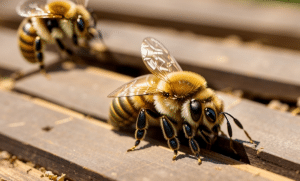
Types of Queen Bees
There are several different breeds of queen bees to choose from when purchasing for your hive. Each breed has its own unique characteristics and traits that may be better suited for certain beekeeping goals or environments. Here are some common types of queen bees:
- Italian Bees: Italian bees are known for their gentle temperament, productivity, and resistance to diseases such as varroa mites. They are excellent honey producers and tend to build up quickly in the spring.
- Carniolan Bees: Carniolan bees originate from Slovenia and are known for their docile behavior and overwintering abilities. They can adjust their population according to nectar availability, making them adaptable in fluctuating conditions.
- Russian Bees: Russian bees have evolved in harsh climates, making them well-suited for colder regions. They display strong hygienic behavior, which helps control pests like varroa mites.
- Buckfast Bees: Buckfast bees were bred by Brother Adam at Buckfast Abbey in England. These hybrid bees combine various European strains, resulting in a hardy and productive bee that exhibits good disease resistance.
- Caucasian Bees: Caucasian bees come from the Caucasus region of Eastern Europe and have adapted to cold winters and hot summers. They have a long brood cycle, making them suitable for regions with shorter honey flows.
It’s important to consider your specific climate, goals, and preferences when selecting a queen bee breed for your hive. Consulting with experienced beekeepers or local associations can provide valuable insights into which type may be best suited for your needs.
Understanding the different breeds of Queen Bees
When it comes to selecting a Buying a Queen Bee for your hive, there are several different breeds to choose from. Each breed has its own unique characteristics and traits that may be better suited for certain beekeeping goals or environments.
Italian bees, for example, are known for their gentle temperament, productivity, and resistance to diseases such as varroa mites. They are excellent honey producers and tend to build up quickly in the spring. Carniolan bees originate from Slovenia and are known for their docile behavior and overwintering abilities. They can adjust their population according to nectar availability, making them adaptable in fluctuating conditions.
Russian bees have evolved in harsh climates, making them well-suited for colder regions. They display strong hygienic behavior, which helps control pests like varroa mites. Buckfast bees were bred by Brother Adam at Buckfast Abbey in England. These hybrid bees combine various European strains, resulting in a hardy and productive bee that exhibits good disease resistance.
Caucasian bees come from the Caucasus region of Eastern Europe and have adapted to cold winters and hot summers. They have a long brood cycle, making them suitable for regions with shorter honey flows.
It’s important to consider your specific climate, goals, and preferences when selecting a queen bee breed for your hive. Consulting with experienced beekeepers or local associations can provide valuable insights into which type may be best suited for your needs.
Characteristics of a healthy Queen Bee
A healthy queen bee is crucial for the overall success and productivity of a bee colony. Here are some key characteristics to look for when assessing the health of a queen bee:
- Age: A young queen bee is generally more productive and has a longer lifespan compared to an older queen. It is recommended to replace queens every 1-2 years to maintain colony strength.
- Physical Appearance: A healthy queen should have a well-developed thorax, abdomen, and wings. Her body should be plump and shiny, indicating good nutrition and vitality.
- Behavior: A strong queen exhibits calm and confident behavior. She moves purposefully through the hive, laying eggs consistently in an organized pattern. Aggressive or erratic behavior may indicate issues with her health or genetics.
- Egg-laying Pattern: The primary role of a queen bee is egg-laying. She should lay eggs in a tight pattern across multiple frames, ensuring the continuous growth of the colony.
- Brood Health: The brood (developing bees) should be healthy and show no signs of disease or deformities such as chalkbrood or misshapen cells.
- Genetics: Queens from reputable breeders with strong genetic lines are more likely to possess desirable traits such as disease resistance, honey production, and docility.
- Mating Success: A successful mating flight ensures genetic diversity within the colony and improves its overall resilience.
Regularly monitoring these characteristics will help ensure that your hive remains strong and productive over time.
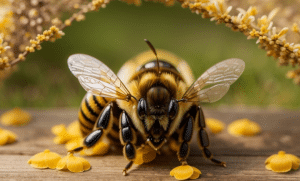
Where to Buy Queen Bees
When it comes to buying queen bees, there are several options available to beekeepers. Whether you prefer to purchase from local suppliers or online sources, it’s important to choose a reputable and reliable supplier. Here are some places where you can buy queen bees:
- Local Beekeeping Suppliers and Breeders: Many beekeeping associations have local suppliers and breeders who offer queen bees for sale. These suppliers often have a good understanding of the local climate and conditions, ensuring that the queens they provide are well-suited for your specific area.
- Online Resources: There are numerous online platforms and websites that specialize in selling queen bees. These platforms allow you to browse through different breeds and select the one that best suits your needs. It’s crucial to read reviews and do thorough research on the seller before making a purchase online.
When choosing where to buy your queen bee, consider factors such as reputation, customer reviews, shipping methods, and guarantees offered by the supplier. It’s also helpful to ask other experienced beekeepers for recommendations.
Remember, buying a high-quality queen is an investment in the success of your hive. By purchasing from trusted sources, you increase your chances of receiving healthy bees with desirable traits such as disease resistance, honey production capabilities, and docility.
Next up: Evaluating Queen Bee Suppliers – Factors to consider when choosing a reputable Queen Bee supplier
Local beekeeping suppliers and breeders
One of the best options for purchasing a Buying a Queen Bee is to find local beekeeping suppliers and breeders. These suppliers are typically experienced in breeding and raising queen bees that are well-adapted to the local climate and conditions.
By purchasing from local suppliers, you can benefit from their knowledge and expertise in selecting queens with desirable traits such as disease resistance, productivity, and docility. They can also provide valuable advice on how to integrate the new queen into your existing hive.
To find local suppliers and breeders, reach out to your local beekeeping association or club. They often have a network of trusted individuals who are known for producing high-quality queens. Attend meetings or events where you can meet fellow beekeepers who may be able to recommend reliable sources.
When buying from a local supplier or breeder, it’s important to ask questions about their breeding practices, such as whether they use artificial insemination or natural mating methods. Additionally, inquire about any guarantees they offer regarding the health and performance of their queens.
Buying locally not only supports your community but also reduces stress on the queen during transportation since she doesn’t have to endure long travel distances. It also allows you to establish a relationship with the seller, which can be beneficial for future purchases or seeking advice.
Overall, purchasing from reputable local suppliers and breeders ensures that you receive healthy queen bees that are well-suited for your specific location, increasing the chances of success for your hive.
Online resources for purchasing Queen Bees
In addition to local suppliers and breeders, there are also online resources available for purchasing queen bees. These platforms provide convenience and a wider selection of queen bees from different regions and breeds.
One popular online option is beekeeping supply websites, where you can find a variety of queen bees for sale. These websites often have detailed descriptions of the queens, including their lineage, characteristics, and performance records. They may also offer customer reviews to help you make an informed decision.
Another option is online forums and beekeeping communities where beekeepers offer queen bees for sale directly. These platforms allow you to connect with experienced beekeepers who may have surplus queens available for purchase. You can browse through listings or post your own inquiry about buying a queen bee.
When purchasing from online sources, it is important to consider shipping conditions and the reputation of the seller. Look for sellers who have good feedback ratings or positive reviews from other buyers. Additionally, inquire about their shipping methods to ensure that the queen will be well-protected during transit.
Keep in mind that when buying queens online, there may be additional costs associated with shipping and handling fees. It’s also crucial to plan ahead and coordinate delivery dates with the seller to minimize stress on the queen during transportation.
Overall, online resources provide convenient access to a wide range of queen bees from different locations, allowing you to find the best fit for your specific needs and preferences.
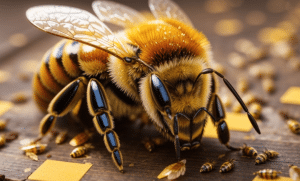
Evaluating Queen Bee Suppliers
When it comes to buying a queen bee, it is important to choose a reputable supplier. Evaluating queen bee suppliers can help ensure that you are getting a healthy and high-quality queen for your hive.
One key factor to consider when evaluating suppliers is their reputation in the beekeeping community. Look for suppliers who have positive reviews and feedback from other beekeepers. This indicates that they have a track record of providing reliable and healthy queens.
Another important aspect to evaluate is the source of the queens. Ideally, you want to buy from suppliers who breed their own queens or source them from trusted breeders with good genetics. This helps ensure that you are getting bees with desirable traits such as gentleness, productivity, and disease resistance.
Consider the availability of different breeds or strains of queens offered by the supplier. Some beekeepers may prefer specific breeds based on their climate or management practices. A good supplier will offer a variety of options to cater to different needs.
It’s also essential to inquire about any guarantees or warranties provided by the supplier. Reputable suppliers often offer replacement policies if there are issues with the queen’s health or performance within a certain timeframe after purchase.
Lastly, consider the customer service and support provided by the supplier. A knowledgeable and responsive supplier can provide guidance and assistance throughout your queen rearing journey.
By carefully evaluating queen bee suppliers based on these factors, you can increase your chances of acquiring a healthy and productive queen for your hive.
Factors to consider when choosing a reputable Queen Bee supplier
When it comes to choosing a reputable Queen Bee supplier, there are several important factors to consider. These factors can help ensure that you are getting a healthy and high-quality Queen Bee for your hive.
- Reputation: Look for suppliers who have a positive reputation within the beekeeping community. Seek recommendations from fellow beekeepers or check online reviews and forums to gauge their credibility.
- Source of Queens: It is crucial to inquire about the source of the queens offered by the supplier. Ideally, you want to buy from suppliers who breed their own queens or source them from trusted breeders with good genetics. This ensures that you are getting bees with desirable traits such as gentleness, productivity, and disease resistance.
- Variety of Options: Consider the availability of different breeds or strains of queens offered by the supplier. Some beekeepers may prefer specific breeds based on their climate or management practices. A good supplier will offer a variety of options to cater to different needs.
- Guarantees and Warranties: Inquire about any guarantees or warranties provided by the supplier. Reputable suppliers often offer replacement policies if there are issues with the queen’s health or performance within a certain timeframe after purchase.
- Customer Service and Support: Lastly, consider the level of customer service and support provided by the supplier. A knowledgeable and responsive supplier can provide guidance and assistance throughout your queen rearing journey.
By carefully evaluating these factors when choosing a Queen Bee supplier, you can increase your chances of acquiring a healthy and productive queen for your hive.
Ensuring the health and quality of the Queen Bee
Ensuring the health and quality of the Queen Bee is crucial for the success of your hive. Here are some key steps to take:
- Choose a reputable supplier: When purchasing a Queen Bee, it is important to buy from a reputable supplier. Look for suppliers who have a positive reputation within the beekeeping community and offer guarantees or warranties.
- Inspect the queen upon arrival: Once you receive your Queen Bee, carefully inspect her for any signs of damage or disease. Look for a strong and active queen with an elongated body and well-developed wings.
- Introduce the queen properly: When introducing the new Queen Bee into your hive, follow best practices to ensure acceptance by the worker bees. This may involve using techniques such as cage introduction or newspaper introduction methods.
- Monitor hive behavior: After introducing the new queen, closely monitor hive behavior to ensure that she is accepted by the worker bees. Watch for signs of aggression towards her or unusual behavior in the colony.
- Provide optimal conditions: To support a healthy queen, make sure your hive has adequate food stores, proper ventilation, and protection from pests and diseases.
- Regular inspections: Conduct regular inspections of your hive to check on the health and performance of your Queen Bee. Look for signs of brood production, honey stores, and overall colony vitality.
By taking these steps to ensure the health and quality of your Queen Bee, you are setting up your hive for success and increasing its chances of thriving in the long run.
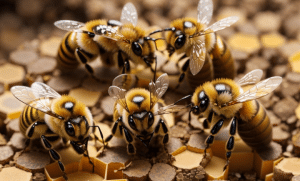
Introducing the Queen Bee to Your Hive
Introducing a new Queen Bee to your hive is a critical process that requires careful attention and proper techniques. Here are some essential steps to follow:
- Timing: Choose the right time to introduce the Queen Bee when the worker bees are less likely to be aggressive or in swarm mode. Avoid introducing her during periods of high nectar flow or other major disturbances.
- Preparing the colony: Before introducing the Queen Bee, ensure that your hive is healthy and stable. Make sure there are ample food stores, sufficient space for brood production, and proper ventilation.
- Cage introduction method: One common method is using a queen cage, which allows the worker bees to become accustomed to her pheromones before direct contact. Place the cage between frames with young nurse bees for better acceptance.
- Newspaper introduction method: Another option is using the newspaper technique, where you place a sheet of newspaper between two hives – one with an established colony and another with a new queen. The worker bees gradually chew through the paper barrier, allowing them to merge peacefully.
- Monitoring acceptance: After introducing the new queen, regularly monitor hive behavior for signs of acceptance or rejection. Look out for increased activity around her cage or any aggression towards her from worker bees.
- Integration process: Once accepted by the colony, it’s crucial to allow time for integration before conducting any further inspections or interventions in order not to disrupt their newly established harmony.
Remember that each hive may have its unique dynamics and preferences when it comes to accepting a new queen bee. It’s essential to closely observe your colony’s behavior throughout this process and make adjustments as needed.
Monitoring the acceptance and integration process
After introducing the new Queen Bee to your colony, it is crucial to closely monitor the acceptance and integration process. This will ensure that the worker bees accept her as their new leader and that she integrates smoothly into the hive. Here are some key steps to follow during this monitoring period:
- Observe Hive Behavior: Pay close attention to how the worker bees react to the presence of the new queen. Look for signs of aggression or acceptance. Increased activity around her cage may indicate that they are accepting her.
- Check for Queen Cells: Keep an eye out for queen cells being built in the hive. If worker bees start constructing queen cells, it could be a sign that they are rejecting or replacing the new queen.
- Observe Egg-Laying Activity: Monitor whether the new queen begins laying eggs within a few days after introduction. This indicates that she has been accepted by the colony and is starting her role as a productive egg-layer.
- Evaluate Brood Production: Assess whether there is an increase in brood production after introducing the new queen. A healthy and accepted queen should lead to a thriving population of brood in various stages of development.
- Maintain Stability: During this monitoring period, it’s important not to disturb or disrupt the hive unnecessarily. Avoid conducting further inspections or interventions unless absolutely necessary, as this can cause stress and hinder integration.
By carefully observing these indicators, you can gauge if your colony has successfully accepted and integrated with their new Queen Bee. Adjustments may be needed based on their behavior, so stay attentive and proactive throughout this process.
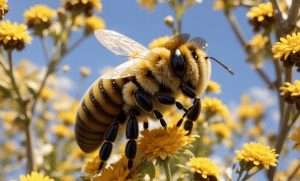
In conclusion, choosing the right Queen Bee for your hive is essential for the success and health of your colony. By selecting a high-quality Queen Bee, you can reap numerous benefits such as increased honey production, disease resistance, and improved temperament.
When buying a Queen Bee, it is important to consider factors such as the breed, genetics, and reputation of the supplier. Researching local beekeeping suppliers and breeders can provide you with options close to home. Additionally, online resources offer convenience and access to a wider selection.
Evaluating Queen Bee suppliers should involve assessing their experience, customer reviews, and the quality of their bees. Ensuring that the Queen Bee is healthy and free from diseases is crucial for maintaining a thriving colony.
Introducing a new Queen Bee to your hive requires careful monitoring during the acceptance and integration process. Observing hive behavior, checking for queen cells, monitoring egg-laying activity, evaluating brood production are all important indicators of successful integration.
A healthy Queen Bee leads to a strong and productive colony. It’s vital to prioritize her well-being by providing proper care and attention throughout her reign in the hive. Remember that purchasing a high-quality Queen Bee is an investment in the future of your beekeeping endeavors.
Frequently Asked Questions about buying and introducing Queen Bees:
- How do I know if I have chosen a good-quality queen bee?
- Can I introduce multiple queen bees into one hive?
- What should I do if my worker bees reject the new queen?
- How long does it take for a new queen bee to start laying eggs?
- Can I raise my own queens instead of buying them?
By addressing these questions and following best practices in queen bee selection and introduction processes,you can establish a strong foundation for your beekeeping journey
Importance of a healthy Queen Bee for a thriving bee colony
A healthy Queen Bee is essential for the success and prosperity of a bee colony. She plays a crucial role in maintaining the hive’s population, productivity, and overall well-being.
First and foremost, the Queen Bee is responsible for laying eggs, which ensures the continuous growth and sustainability of the colony. A healthy queen can lay up to 2,000 eggs per day during peak season, ensuring a strong workforce of worker bees to collect nectar, produce honey, and care for the brood.
Furthermore, a healthy queen contributes to disease resistance within the hive. A robust immune system allows her to produce pheromones that help regulate the behavior of worker bees and prevent diseases from spreading. This leads to a more resilient colony that can better withstand pests and pathogens.
In addition to reproductive functions, a healthy queen also influences the temperament of her offspring. Through genetic traits passed down from previous generations, she can influence their behavior and overall disposition towards aggression or docility. This is important for maintaining harmony within the hive and minimizing conflicts among worker bees.
Overall, investing in a high-quality Queen Bee is crucial for establishing a thriving bee colony. By prioritizing her health through proper care and attention, beekeepers can ensure increased honey production, disease resistance, improved temperaments among worker bees,and long-term sustainability within their apiary.
Frequently Asked Questions about buying and introducing Queen Bees.
Here are some frequently asked questions about buying and introducing Queen Bees:
- Why should I buy a Queen Bee instead of letting my colony raise their own?
Buying a Queen Bee ensures that you have a high-quality and genetically diverse queen for your hive. It also allows you to introduce desirable traits, such as disease resistance or honey production, into your colony.
- Where can I buy a Queen Bee?
You can purchase Queen Bees from local beekeeping suppliers and breeders or through online resources. Make sure to choose reputable sources known for providing healthy and well-mated queens. - How do I choose the right Queen Bee for my hive?
Consider factors such as the desired traits, breed preferences, and the reputation of the supplier when selecting a queen bee. Look for suppliers who prioritize quality assurance and provide information on breeding practices. - How do I introduce a new Queen Bee to my colony?
Introducing a new queen bee requires careful planning to ensure acceptance by worker bees. Methods include using introduction cages, direct release with candy plug, or newspaper method. Monitor the process closely to prevent aggression or rejection. - What signs indicate that my introduced queen is accepted by the colony?
Look for positive signs like workers feeding and grooming the new queen, building comb around her cage, or eggs laid within 3-7 days after introduction.
Remember, successful integration relies on proper timing, gradual introductions, and monitoring hive behavior throughout the process.
And there you have it, your comprehensive guide to navigating the world of online Buying a Queen Bee purchases. While it can be a daunting task, armed with the knowledge you’ve gained here, you’re now better equipped to make informed decisions that will lead to a thriving beekeeping experience.
Remember, investing in quality and planning for the future are key to your success in this buzzing endeavor. Thanks for following our guide, and should you have any stories, questions, or tips of your own, don’t hesitate to share. Your input could be invaluable to fellow aspiring beekeepers. Let’s continue to learn and grow our colonies together!



